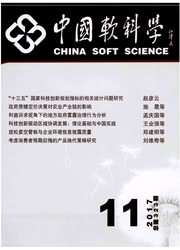

 中文摘要:
中文摘要:
知识产权保护对发展中国家经济增长的影响成为近年来倍受争议的话题,在梳理现有文献的基础上,本文基于发展中国家的研究视角,采用中间产品种类扩张的内生增长模型,将研发产出函数的非线性性质引入模型,同时考虑自主创新与技术模仿两种技术进步方式,在技术模仿能力内生的基础上,探讨人力资本、知识产权保护与稳态经济增长之间的内在关系与作用机理,结果表明:发展中国家知识产权保护水平和稳态人均经济增长率、研发部门人力资本配置之间呈倒u型关系;加强知识产权保护不一定有利于发展中国家经济增长,当知识产权保护水平处于临界值之下时,提高知识产权保护水平能有效促进经济增长,较高的人力资本水平和较强的模仿能力能进一步促进知识产权保护的经济增长效应,而稳态人均增长率的提高也将促使人力资本向研发部门流动。其政策含义十分明显:发展中国家要根据人力资本水平与技术差距等因素的动态变化相应调整知识产权保护强度,加大教育与研发投入,加速人力资本积累,并合理运用知识产权政策有效均衡与激励自主创新及技术模仿,促进科技进步与产业转型升级;发展中大国尤其是中国要根据不同产业与地区的人力资本与技术水平,实施差别化的产业与区域知识产权政策,最大效用地促进经济增长。
 英文摘要:
英文摘要:
The impact of intellectual property right protection on developing countries' economic growth has become a much-debated topic in academia. Based on analyzing the main existing literature, from the perspective of developing countries, this paper applies an expanding-variety-type endogenous growth model, introduces nonlinear properties of the R&D output function into this model, takes independent innovation and technological imitation into account and makes an analysis of the relationship among intellectual property right protection, human capital and steady economic growth basedon endogenous capacity of imitation. The results show that level of IP protection reveals an inverted U-type relationship with steady per capita economic growth rate and human capital allocation in R&D department in developing coun- tries. Excessive strengthening of intellectual property right protection does not necessarily always lead to economic growth in developing countries. When the level of IP protection is under the critical value, a higher level of human capital and strong imitate ability will further promote the economic growth effects 0f intellectual property protection, the increase of steady per capita economic growth rate will push more human capital to flow into R&D department. Its policy implications is very obvious,firstly,developing countries should adjust its intellectual property right protection level according to the dynamic change of human capital level and technology, etc ; secondly, developing countries should increase the input of education and R&D to accelerate to accumulate human capital and carry out rational intellectual property right protection policy to equilibrium and encourage independent innovation and technological imitation ,in order to push the progress of science & technology and restructuring & upgrading of industry ; thirdly, developing big countries, such as China, should implement different industry and regional intellectual property right protection policy to push economic growth ba
 同期刊论文项目
同期刊论文项目
 同项目期刊论文
同项目期刊论文
 期刊信息
期刊信息
